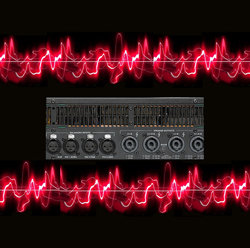
In a real-world power amp with limited current capability, the typical 4-ohm power rating is about 1.5 times the 8-ohm rating, not 2 times. And the 2-ohm rating is about 2 times the 8-ohm rating, not 4 times.
Most power amplifiers are rated for 4-ohm and 8-ohm loads, and high-end models can handle 2-ohm loads as well. A low-impedance load (like 2 ohms) is harder to drive – it draws more current – than a higher-impedance load (like 8 ohms). A “heavy load” means “a low-impedance load.”
Amps with puny power supplies run out of current when they drive low-Z loads. Amps with hefty power supplies can produce more current, hence more power, with low-Z loads.
Check the amplifier data sheet. It should specify how much power the unit can deliver into different loads. If the data sheet provides an 8-ohm and 4-ohm spec, but no 2-ohm spec, that means the amplifier probably can’t drive a 2-ohm load continuously without overheating or failing.
Comparing Amplifier Power Ratings
Let’s move on. Do two amplifiers with the same power rating produce the same power? Not always. Specifying amplifier power only in watts is insufficient.
A complete power rating includes several factors:
• Power per channel
• Number of channels driven simultaneously
• Load impedance
• THD
• Frequency range
• Continuous (long-term) power or peak (short-term) power
Here are a few examples. Suppose one amp produces 500 watts per channel at 0.01% THD. Another amp produces 500 watts per channel at 1% THD. Although both amplifiers could be called “500 watt amplifiers,” the first one will produce more power than the second when both are turned up to the same distortion level.
Or suppose one amplifier puts out 500 watts continuous, and another puts out 500 watts peak (but 250 watts continuous). The first one will sound clean at 500 watts continuous, but the second one will clip if forced to produce 500 watts continuously.
You need to compare apples to apples. 500 watts in one amp is not necessarily the same as 500 watts in another amp. Compare both amps at the same THD, at the same load impedance, at the same continuous power, and over the same frequency range.
Also, manufacturers vary in how conservatively they rate their products. Some companies underrate a unit’s power to allow for manufacturing tolerances – to ensure that all production units will meet the power spec.
Most amps produce a little less power when all channels are driven. That’s because the power supply voltage tends to sag when more channels are in use. Amps with dual independent power supplies don’t have that problem.
Avoid 2-Ohm Operation
Although some amps can handle 2-ohm loads continuously, it’s best not to operate the amplifier that way.
When a loudspeaker’s impedance is specified as 8 ohms or 4 ohms, this is the nominal or average rating. Actually, the impedance varies with frequency, so an 8-ohm rated loudspeaker might be 6 ohms at a certain frequency.
